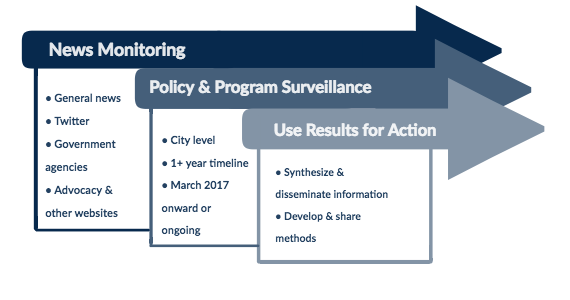Urban Policy and Program Surveillance Project
Monitoring education, environment and housing policy and program developments in select U.S. cities

Summary
Policy surveillance, defined as “the systematic tracking of policies of public importance”1 is an important mechanism for understanding the scope and effectiveness of policies that can impact health. What is learned can be used to expand the geographic reach of successful policies and laws and identify unmet needs for policy development and advocacy strategies in any sector that could positively impact public health.2
Expanding upon this definition, the Urban Health Collaborative initiated a policy surveillance project in 2017 as a way to identify best practices in select cities around the United States that are employing promising or effective policy, programmatic, and budgetary initiatives to promote health equity despite actions or inaction at the federal policy level. While much public health policy is enacted at the federal and state levels, cities play an important role in developing and implementing policies and programs that impact population health.
The goal of this project was to create a system to monitor, document, and disseminate local policy actions that can impact population health and improve health equity. While much public health policy is enacted at the federal and state levels, cities play an important role in developing and implementing policies and programs that impact population health, but systems designed to understand these practices across cities are lacking. As public health researchers with a commitment to health in cities, this project helps to fill this knowledge gap. When more is known and shared about policies that can improve health, the more cities can do to fulfill the promise of health equity in their jurisdictions.
This project began with four cities - Philadelphia, New York City, Washington DC, and Los Angeles. These cities were chosen due to their size, importance as active policy centers, availability of policy tracking tools, and vibrant city council-level public debate. We also chose to focus on policy issues related to the social determinants of health, which are often the focus of cross-sector health equity strategies, including education, the environment, and housing.
Details on Policy Surveillance and our methods
Research Objectives
- Synthesize information from selected cities on selected topics to identify current trends and highlight promising urban action;
- Develop methods that can be replicated in other cities and for other topics;
- Disseminate information and methods to advocates, researchers, and other stakeholders who can use it to improve public health and promote health equity.
Research Methods
Included in the surveillance are legislation, regulations, major programs, and budget plans at the city level. In order to be included, these policy interventions must have a proposed duration of more than one year, and have been initiated after March 2017 (project initiation) or had been ongoing at that time. We collect data from mainstream news websites (e.g., Curbed Philadelphia, Google News), Twitter (e.g., city council members’ accounts), city government agencies, advocacy organizations (e.g., Housing Rights Center, Philadelphia Education Fund), and websites of other academic research centers. Through an iterative process we have developed a customized list of the most relevant online sources to monitor for updates in each of the selected cities on each of the selected topics on a bi-weekly basis. This list is updated, as we discover new sources.

Research Results
Since March, 2017 our searches led to over 300 policies and programs in four cities -- Philadelphia, New York City, Washington DC, and Los Angeles -- related to the topics of education, the environment, and housing. These cities are all making notable efforts to bring positive change to communities and focus additional resources on improving social determinants of health in historically disadvantaged communities. This work shows that cities are adaptive and can operate to protect population health in spite of political activity at the federal level. These selected cities are going above and beyond federal and state requirements to promote health equity in the three topic areas we are monitoring. See examples below.
Environmental Policies
Cities are embarking on long-term initiatives, with 10-30 year goals, to create more sustainable cities. Examples include transitioning to clean energy (e.g., solar), reducing carbon emission and waste, and preserving clean water.
View our Environmental Report
Educational Policies
Cities have short term (3-5 year) strategic plans that focus on engaging children in school, improving equity, quality of education, college and career readiness, graduation rates, safety, and funding.
Housing Policies
Cities are undertaking initiatives to build safe and connected homes, develop affordable residential housing in low-income communities and reduce gentrification, close the gap between income and rent prices, provide services and shelters for homeless population, and improve housing quality.
Next Steps
We plan to expand this surveillance system to 4 additional cities by the end of 2019. We plan to include cities from more U.S. regions (e.g., Midwest, Southwest) not captured in this round of surveillance. We focused mainly on large cities, but future efforts will include assessing the policy environment of smaller cities. We welcome opportunities to build new collaborations with others who are interested in replicating these surveillance efforts to expand its reach and dissemination more broadly.
Acknowledgements
Research Team
References